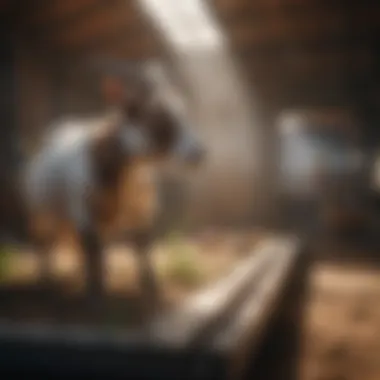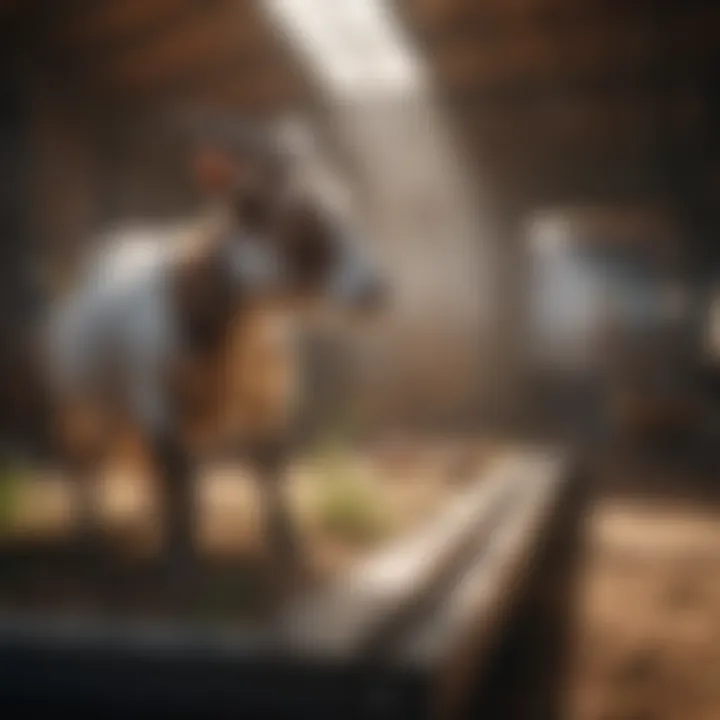Effective Fly Control Strategies for Goat Farming


Intro
Fly control in goat farming is crucial for the overall health and productivity of the herd. Flies are not just a nuisance; they can cause serious health issues, leading to decreased milk production and increased veterinary costs. Understanding the dynamics of fly populations and their behaviors is essential for effective management.
In this guide, we will explore various strategies to repel flies from goats. Our approach includes natural remedies, chemical solutions, and mechanical methods, ensuring a comprehensive overview for all farmers. This article is intended for both novice and experienced goat farmers who are seeking effective ways to enhance animal welfare and optimize farming operations.
Topic Overview
Definition and Importance
Fly repellent strategies refer to the methods used to deter, control, or eliminate flies in goat farming environments. Proper fly management influences not just the health of the goats but also the operational efficiency of the farm. Flies can carry diseases such as bluetongue and can cause stress to animals that may reduce growth rates and milk yield.
Brief History and Evolution
Historically, livestock farmers used a combination of trial and error and traditional knowledge to manage flies. Over time, the introduction of chemical pesticides made significant changes in control strategies. However, the rising concern about environmental impact and animal welfare has led to a resurgence in interest toward natural and sustainable practices. Farmers now face the challenge of balancing effective fly control with these considerations.
Key Techniques and Innovations
Sustainable Farming Practices
Sustainable practices are gaining popularity in fly management. Some methods include:
- Rotation Grazing: Changing grazing patterns can interrupt the life cycles of flies.
- Manure Management: Proper disposal and composting of manure reduce breeding sites for flies.
- Beneficial Insects: Introducing natural predators like parasitic wasps can naturally decrease fly populations.
Advanced Agronomic Technologies
Technological advancements offer innovative solutions for fly management.
- Insect Growth Regulators: These chemicals prevent fly larvae from maturing, thus controlling populations more effectively.
- Traps: Modern traps with attractants can help to monitor and reduce fly numbers significantly.
Practical Applications
Step-by-Step Guides
Implementing a fly management plan can be broken into actionable steps:
- Assess the Situation: Identify fly species present and the common areas of infestation.
- Choose Strategies: Select from natural, chemical, or mechanical methods as fits best for your farm.
- Implement Solutions: Begin applying your solutions and monitor their effectiveness.
- Evaluate and Adjust: Keep track of results and be willing to adjust your strategy as needed.
Case Studies or Real-World Examples
One notable example is the use of pyrethrin-based sprays in a dairy goat farm in Ohio. The owner reported a significant reduction in fly populations after implementing a routine application during peak fly seasons. Adaptions were made to integrate more sustainable practices alongside chemicals, ultimately leading to improved goat health and productivity.
"Effective fly control is not just about repelling flies, it's about ensuring the health and productivity of the herd."
By exploring different aspects of fly repellents and management strategies, farmers can create a tailored approach suited to their unique farming context.
Understanding the Importance of Fly Control in Goat Farming
Fly control in goat farming is critical for several reasons. First, goats are particularly sensitive to fly infestations. Flies can transmit diseases, lead to stress, and cause skin irritations. Without proper management, fly populations can grow rapidly, exacerbating health issues among the herd. Maintaining their health ensures that goats remain productive, which is a core concern for any farmer.
In addition to health impacts, fly control directly influences the economic viability of goat farming. Farmers often face significant financial losses due to reduced milk and meat productivity caused by fly-related stress. Thus, an effective fly control strategy is not merely a health concern; it is also an economic imperative.
The behavior of flies—how they breed and where they thrive—requires careful observation. Understanding their life cycle can help in developing targeted strategies to manage their populations. This knowledge supports optimum timing for interventions, making them more effective overall.
Impact of Flies on Goat Health
Flies negatively affect goat health in various ways. They are vectors for harmful diseases, such as bluetongue and leptospirosis, which can spread through their bites. Additionally, flies can cause irritations like fly strike, which is when flies lay eggs on open wounds, leading to further complications. Such conditions not only lower the quality of life for goats but may also lead to increased veterinary costs, impacting the farmer's bottom line.
When goats are frequently annoyed by flies, their feeding habits can change. They might stop eating adequately, leading to weight loss. This unintentional malnutrition can pose risks, especially in breeding or lactating goats, where nutrient requirements are higher. Moreover, stress from fly irritation can cause behavioral changes, affecting overall herd dynamics.
Economic Consequences of Fly Infestation
The economic ramifications of fly infestations can be severe. Farmers may experience decreased milk production due to stressed and unhealthy goats. Research indicates that significant fly populations can reduce milk yield by up to 20%. Similarly, meat production can be affected, as weight gains decline when goats are preoccupied with flies instead of foraging.


In addition, the costs of managing infestations can accumulate. If a farmer relies solely on chemical solutions, expenditures can quickly add up, creating strain on resources. Moreover, the potential losses in animal health must be accounted for in overall financial planning.
Fly Life Cycle and Behavior
Understanding the life cycle and behavior of flies is essential for effective control. Most flies undergo four life stages: egg, larva, pupa, and adult. The female lays eggs in manure, where conditions are suitable for larvae. Within a week, they can progress to adulthood. This rapid life cycle allows flies to proliferate quickly and necessitates prompt action by goat farmers.
Flies tend to thrive in warm weather, making summer months particularly challenging for goat farmers. They are attracted to areas with ample manure or decaying organic matter, which makes barn design and maintenance crucial. By knowing where flies are most likely to breed and congregate, farmers can implement preventive measures to limit their populations early on.
Natural Fly Repellent Options
Natural fly repellent options are an essential part of effective fly management in goat farming. They provide a range of benefits, including reduced chemical exposure for both goats and humans. These methods are often preferred because they can be safer for the livestock, more environmentally friendly, and easier to implement in day-to-day farm operations. Understanding natural fly repellents helps farmers select suitable products that align with their farming practices and animal welfare priorities. This section will explore two primary natural options: essential oils and herbal remedies, both of which offer unique benefits and considerations.
Essential Oils as Fly Deterrents
Essential oils have gained attention for their potent properties in deterring flies. They are concentrated plant extracts that can be effective in repelling various types of flies that affect goats. Their advantages include a pleasant aroma and low toxicity when used properly. However, the variability in effectiveness depends largely on the specific type of oil and how it is applied.
Popular Essential Oils
Several essential oils are well-regarded for their fly-repellent qualities. Oils such as citronella, eucalyptus, and peppermint are notable for their strong scents that can mask the odors attracting flies. Citronella is particularly popular as it has been widely used for many years in various types of fly control products. The key characteristic of these oils is their ability to disrupt the sensory cues that flies rely on for locating hosts. This makes them a beneficial choice for goat farmers seeking alternatives to harsh chemicals.
While these oils can provide significant benefits in fly control, there are also disadvantages. The potency of the oils may diminish quickly when exposed to environmental conditions, limiting their use over time. Additionally, careful handling is necessary, as concentrated essential oils can occasionally cause skin irritation in both livestock and humans.
Application Methods
Application methods greatly impact the effectiveness of essential oils as fly repellents. Farmers can use these oils in several ways, such as dilution in carrier oils for topical application or diffusing them in goat barns to create an aromatic environment. Diluting essential oils before application is a common practice that enhances safety for both the goats and the handlers. This method is a preferred choice for many farmers because it is straightforward to implement and can integrate into routine care for the animals.
However, the unique feature of these application methods is that they require careful monitoring. Farmers must be aware of the concentration of oils and their frequency of application. Overuse can potentially overwhelm the goats or lead to reduced effectiveness over time. Therefore, adapting application techniques to specific farm settings can maximize the benefits while minimizing risks.
Herbal Remedies and Their Efficacy
Herbal remedies are another natural option for fly control in goats. These remedies, often made from common garden plants, can harbor properties that deter flies. For example, plants like rosemary and basil can be crushed and spread around the barn area. These plants offer a practical solution since many farmers have access to them without incurring high costs. While research on the efficacy of herbal remedies is still developing, several anecdotal reports suggest positive outcomes in reducing fly populations.
Some herbs are known for their strong odors, which can repel flies. The key consideration here is the availability of these plants and the context of their use. They may require more frequent application or renewal than other methods, but can be integrated naturally into existing farm operations, offering additional benefits such as providing shade and nutrients.
Chemical Fly Repellents
Chemical fly repellents are a vital component of an effective fly management strategy in goat farming. They provide farmers with immediate relief from fly infestations, which can have severe impacts on both animal health and farm productivity. These repellents work by interfering with the flies' sensory systems, making the environment less hospitable for their presence. Understanding the different types of chemical repellents available can help farmers choose the right options to protect their goats more effectively.
Types of Chemical Repellents
Permethrin
Permethrin is a synthetic chemical that is widely recognized in agricultural use, particularly in animal husbandry. Its key characteristic is its ability to repel a broad spectrum of flies effectively. It works by disrupting the nervous system of insects, leading to their incapacitation. This beneficial property of Permethrin makes it a popular choice among goat farmers seeking immediate control of fly populations.
A unique feature of Permethrin is its residual activity; it remains effective on surfaces for an extended period. This means that even after application, it continues to provide protection as flies come into contact with treated areas. However, it is essential to consider that disadvantages include potential toxicity to beneficial insects and the environment if not used properly. Therefore, careful application and adherence to guidelines are critical.
Pyrethroid Products
Pyrethroid products are closely related to Permethrin and belong to a category of synthetic chemicals that mimic the natural pyrethrins found in chrysanthemum flowers. The key characteristic of these products is their rapid knockdown effect on flying insects. Farmers appreciate their quick action in reducing fly numbers, which contributes significantly to improving goat welfare and productivity.
Pyrethroids are versatile; they come in various formulations, such as sprays and pour-ons, making them adaptable for different farm situations. A unique feature of Pyrethroids is their low toxicity to livestock when used as directed, though they can be harmful to aquatic organisms. A notable advantage is their effectiveness against both adult flies and larvae, an important consideration for comprehensive fly management. Despite this, the potential for flies to develop resistance to these chemicals exists, thus necessitating rotation with other control methods.
Safety Considerations for Use
When utilizing chemical fly repellents, safety is paramount. Farmers must take careful measures to ensure the health of their goats and the surrounding environment. Applying repellents in accordance with safety guidelines can reduce risks associated with chemical exposure.
Some key safety points include:
- Always read and follow the product labels for specific instructions.
- Use appropriate personal protective equipment (PPE) during application.
- Ensure proper ventilation in areas where chemicals are used.
- Store chemicals securely, away from livestock and children.
- Monitor livestock for any adverse reactions post-application.
Regulatory Compliance and Labels
Adhering to regulatory compliance is essential in the application of chemical fly repellents. Each product comes with a specific label that outlines the usage instructions, safety precautions, and environmental impact considerations. Familiarizing oneself with these regulations helps in selecting the right product and applying it correctly.
Understanding label information is crucial for effective usage. Key aspects include:


- Active ingredients: Knowledge of what chemical is present and its function.
- Usage directions: Clear instructions on how and when to apply the product.
- Warnings and precautions: Important safety information to protect both the user and the goats.
- Environmental impact: Potential effects on non-target organisms and the surroundings.
Following these aspects ensures responsible use of chemical repellents in goat farming and contributes to long-term fly control success.
Mechanical and Physical Fly Control Techniques
Mechanical and physical fly control techniques play a critical role in managing fly populations around goats. These methods can effectively reduce the number of flies present and thus lower the risk of spread of diseases. They often work in conjunction with chemical control and natural solutions, making them pivotal in an integrated pest management approach.
Using mechanical and physical strategies can benefit both farmers and goats. Effective physical barriers and traps not only minimize the number of flies but also help to improve the overall health of the livestock. Furthermore, these methods are often safer and environmentally friendly compared to chemical solutions, making them appealing to farm owners looking to maintain organic practices.
Fly Traps and Lures
Fly traps and lures are essential tools in the battle against fly infestations. Various types of fly traps exist, such as sticky traps and bait traps. Sticky traps capture flies as they land, while bait traps lure them in with attractants that are irresistible to the pests.
Fly traps can be placed strategically around barns and grazing areas. They help in monitoring fly populations and can significantly reduce flies causing discomfort to goats. Regular maintenance is necessary to ensure these traps work efficiently, and the traps need to be emptied and replaced as required.
Proper Barn Design and Maintenance
Good barn design and maintenance can significantly contribute to fly control. When a barn is constructed with the correct features, it reduces the likelihood of fly infestations considerably. Key aspects of barn design include adequate ventilation systems and effective manure management strategies.
Ventilation Systems
Ventilation systems are essential for maintaining airflow within barns. Proper airflow assists in drying out areas that could harbor flies, thus decreasing their breeding grounds. A well-ventilated barn can also help regulate temperature, making it less attractive to flies.
One key characteristic of effective ventilation systems is their ability to reduce humidity levels. High humidity creates an ideal environment for flies to thrive. Therefore, by implementing an efficient ventilation system, farmers can combat the conditions favorable for fly propagation. Additionally, natural ventilation methods, such as windows and vents, allow fresh air to circulate throughout the barn, potentially minimizing the presence of flies.
However, improper ventilation can lead to issues with drafts or unhealthy air quality. Thus, it is important to balance airflow with creating a comfortable environment for the goats.
Manure Management
Manure management is crucial for fly control. Flies are attracted to manure, where they lay their eggs. Proper handling of manure reduces fly breeding significantly. Farmers should implement regular cleaning routines in barns and ensure that manure is properly stored and disposed of.
The key feature of effective manure management is the timely removal of waste. By regularly cleaning up manure, farmers can disrupt the lifecycle of flies, limiting their ability to reproduce. It is also beneficial to consider the use of composting methods, which can further reduce fly populations.
A challenge with manure management is the labor required to maintain cleanliness. Additionally, improper storage of manure can still lead to fly issues. Therefore, consistent monitoring and adjustment of manure management practices are necessary to ensure ongoing fly control.
Integrated Pest Management (IPM) Approach
The Integrated Pest Management (IPM) approach is crucial in maintaining effective fly control in goat farming. It emphasizes the use of a combination of methods that work together synergistically. Rather than relying on a single strategy, IPM incorporates biological, cultural, mechanical, and chemical controls. This multifaceted methodology reduces dependency on chemical pesticides and minimizes environmental impact while fostering sustainable agricultural practices.
The primary benefit of an IPM approach is its ability to adapt to changing conditions. Fly populations can vary based on environmental factors, goat nutrition, and farming practices. By combining methods, farmers can respond more effectively to these variations, ensuring that control measures are both efficient and cost-effective. This adaptability can lead to improvements not only in fly management but also in overall herd health and productivity.
Farmers must also consider specific key elements such as environmental sustainability, the health of livestock, and the reduction of chemical residues in products. The IPM strategy encourages ongoing education and engagement, leading to a more informed approach to pest management.
Combining Methods for Effectiveness
Utilizing various control methods is central to the IPM philosophy. Combining natural, mechanical, and chemical strategies enhances overall effectiveness against fly infestations. For example, grazing goats in rotational patterns can disrupt fly breeding cycles, while strategically using fly traps can reduce adult fly populations in barns. Moreover, essential oils and herbal repellents can be integrated into daily routines, providing natural deterrents alongside chemical options.
This multifactorial approach recognizes that no single method is universally effective across all situations. Rather, the integration of these methods creates a more resilient management system. This results in healthier livestock, decreased fly reproduction rates, and reduced reliance on chemical intervention.
Monitoring and Assessment Techniques
Effective monitoring is integral to any successful IPM strategy. Farmers need to assess fly populations frequently and systematically. This involves visual inspections and counting the number of flies in various areas around the farm. By using fly traps, data can be gathered to analyze trends over time, allowing for informed decision-making.
Additionally, assessments should include evaluating the effectiveness of implemented fly control measures. Key performance indicators can include changes in fly populations, improvements in goat health, and overall herd productivity. Making adjustments based on gathered data helps refine strategies, ensuring that methods remain relevant and efficient.
Monitoring should not be a one-time activity but a continuous process that enables proactive adjustments. Documentation of findings aids in understanding the life cycle of flies and their behavior patterns. This, in turn, allows for better-targeted interventions that can contribute significantly to long-term fly control success.
Evaluating the Effectiveness of Fly Control Measures
In goat farming, it is crucial to implement effective fly control measures. Evaluating the effectiveness of these measures ensures that farmers protect their herds from the negative effects of fly infestations. This evaluation is not only important for ensuring the health of the goats but also for achieving economic sustainability. By assessing the various fly control strategies, farmers can ascertain which methods work best under their specific conditions and environments.
A thorough evaluation includes analyzing both the immediate effects on goat health and longer-term impacts on productivity. Factors such as the level of infestation, the health of the goats, and the ease of implementing each control strategy must be considered. Fly control measures should be regularly reassessed to adapt to changing circumstances within the farm.
Additionally, such assessments help in resource optimization. By determining the most effective methods, farmers can allocate their limited resources more efficiently, ensuring that they do not waste time or money on ineffective strategies. With the right approach to evaluation, goat farmers can maintain optimal herd health and improve overall farm productivity.


Key Performance Indicators to Consider
To effectively evaluate fly control measures, farmers must focus on specific Key Performance Indicators (KPIs). These indicators provide quantifiable data that reflect the effectiveness of different strategies. Consider the following KPIs:
- Fly Count: Regularly counting flies in various areas of the farm helps gauge the effectiveness of control measures. A decrease in fly population indicates successful management.
- Goat Health Metrics: Monitoring factors such as weight gain, milk production, and overall health can reveal the impact of fly control on the goats. Healthy goats are often less stressed and show better performance.
- Economic Impact: Assessing cost savings derived from reduced veterinary bills, improved milk production, and less feed waste can clarify the financial implications of fly control strategies.
- Farmer Satisfaction: Surveys or feedback from farmers regarding their satisfaction with fly control methods can also provide insight into effectiveness. This informal KPI can help adjust management practices.
By focusing on these KPIs, goat farmers can compare results over time and across different strategies used on the farm. This assessment leads to informed decisions and better management of resources.
Adjusting Strategies Based on Outcomes
After evaluating the effectiveness of fly control measures, adjustments may be necessary. No single method works for every situation. Therefore, adapting strategies based on the evaluation results is essential for continued success in fly management.
Some considerations for adjusting strategies include:
- Review Results: Analyze the collected data and compare it with desired outcomes. Identify any discrepancies and consider whether the strategies employed were appropriate in addressing the problems faced.
- Experiment with Alternatives: Should the current measures not meet expectations, consider trialing alternative methods. For instance, if a specific chemical repellent failed to reduce fly populations, switching to a different product or exploring natural repellents may yield better results.
- Increase Monitoring: Continuous monitoring can help in identifying new fly populations early. If shifts in fly behavior or emergence of resistant strains are noted, making prompt adjustments to the strategy becomes necessary.
- Training and Education: Staying informed on the latest research and techniques in pest management can provide new insights. Investing time in learning can improve decision-making and strategy implementation.
Future Directions in Fly Control Research
Exploring the future directions in fly control research is essential for advancing goat farming practices. Continued research can lead to innovative solutions that effectively address the persistent challenges posed by fly infestations. Understanding emerging technologies and sustainability considerations is crucial, as these elements can significantly enhance both animal well-being and farm productivity.
Emerging Technologies
Emerging technologies present promising opportunities for fly control in goat management. Innovations like biopesticides represent a shift toward more environmentally friendly solutions. These products utilize naturally occurring substances to suppress pest populations. For example, beneficial microorganisms can target fly larvae without harming non-target species.
Another notable advancement is the use of automated monitoring systems. These systems can detect fly populations through traps that are equipped with sensors. By collecting real-time data, farmers can make informed decisions regarding the timing and application of control measures. The integration of mobile applications for fly monitoring can further enhance this approach, providing farmers with easy access to crucial data about fly behavior on their farms.
Effective use of genetic engineering is also worth noting. Researchers are investigating genetically modified organisms that could be introduced to target specific fly populations or disrupt their reproductive cycles. This could contribute to natural population control, reducing the reliance on chemical methods.
Sustainability and Environmental Considerations
Sustainability should be at the forefront of fly control research. Farmers increasingly seek solutions that align with ecological preservation and animal welfare. Sustainable practices not only help to maintain ecological balance but also appeal to a growing consumer base that prioritizes environmentally friendly farming methods.
Research into organic farming methods has gained momentum. Utilizing natural repellents, such as certain plant extracts, is one area of focus. Investigating indigenous plants that naturally repel flies can lead to effective, low-cost solutions that are safer for livestock. This can minimize chemical inputs and help maintain soil health.
Additionally, the beneficial practices of rotational grazing can be emphasized more in future research. This method involves moving goats to different pastures, reducing the buildup of fly populations due to decreased manure accumulation in any single area. This way of farming is sustainable and can improve pasture health while managing pests more effectively.
Case Studies of Successful Fly Management
Case studies serve as practical illustrations of fly management techniques that have effectively enhanced animal welfare and productivity on goat farms. They provide insight into real-world applications of various strategies and allow farmers to learn from each other's experiences. Such studies highlight which methods yield significant results and help avoid common pitfalls.
Innovative Farm Practices
Innovative practices emerge from a need to adapt and create sustainable solutions to fly control. One notable case study took place on a farm in Kentucky where the integration of innovative physical barriers significantly reduced fly populations. The use of specialized screen doors and fly-repellent curtains helped to limit entry of flies into barn areas where goats are kept.
Another effective practice was observed in a North Carolina farm, which implemented a rotational grazing system. By rotating their goats to different pastures, they effectively disrupted the fly life cycle. This practice not only reduced fly infestations, but also improved pasture health.
Farmers reported that training staff on effective fly management techniques was essential. For example, regular monitoring of fly numbers and timely responses to spikes in infestations were implemented. Additionally, incorporating fly traps in both the barn and pasture areas yielded a visible decrease in fly presence, enhancing overall goat health.
Lessons Learned from Failures
The examination of failures in fly management can be just as instructive as successful strategies. A notable example is a farm in Texas where the reliance on a single method—a chemical spray—proved ineffective long-term. Initially, it showed promising results, but over time, flies developed resistance, leading to increased infestations.
Another lesson came from a farm in New York that neglected proper barn maintenance. Poor sanitation practices led to an accumulation of manure, creating an ideal breeding ground for flies. This oversight resulted in a complete overhaul of their fly management approach, emphasizing the importance of regular cleaning and maintenance.
"Regular manure removal and appropriate waste management are paramount in fly control. Neglecting these aspects can lead to significant infestations."
Farmers learned that diversification of methods is essential. Combining natural repellents, biological controls, and manual traps can create a more robust defense against flies. This multi-faceted approach not only prevents resistance build-up but also adapts to varying environmental conditions.
Epilogue
In this article, we discussed the significance of fly management in goat farming. Effective control of fly populations is crucial for ensuring the health and productivity of goats. Livestock can face various health issues due to fly infestations, such as stress, decreased milk production, and increased susceptibility to diseases. Therefore, a comprehensive understanding of effective fly control strategies can greatly benefit farmers.
Summary of Key Points
- Impact of Flies on Goat Health: Flies lead to various health issues in goats, including irritation and disease transmission.
- Natural and Chemical Options: A mix of natural repellents, such as essential oils, and chemical repellents, like Permethrin, can provide effective results.
- Mechanical Techniques: Implementing physical barriers and using traps can reduce fly populations noticeably.
- Integrated Pest Management: Combining different methods is essential for a holistic approach to fly control.
- Continuous Monitoring: Adjustments based on ongoing assessment of fly control strategies are necessary to ensure effectiveness.
Recommendations for Goat Farmers
- Routine Monitoring: Regularly check goat health and fly populations to determine the best control measures.
- Utilization of Diverse Methods: Do not rely solely on one method. Incorporate both natural and chemical options alongside physical traps to maximize efficacy.
- Maintain Cleanliness: Proper barn maintenance and manure management help in deterring flies from breeding.
- Stay Informed: Keep up with the latest research and emerging technologies related to fly control. Stay educated on environmental impacts and sustainable practices.
- Adjust Strategies: Based on observed outcomes, be prepared to modify your approach. Use key performance indicators to assess the success of your fly control measures.
An integrated and proactive approach is critical for managing fly populations effectively in goat farming. Staying informed and adaptable plays an essential role in ensuring the health and productivity of goats.



